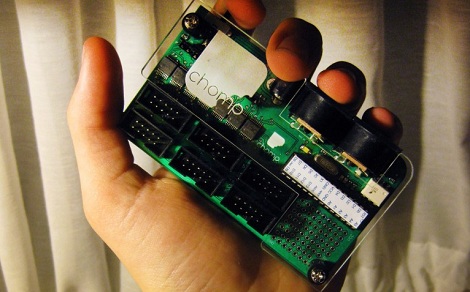
Although MIDI was originally designed for 1 MHz computers with 64 kB of RAM, it’s still an industry standard almost 30 years after its introduction. Even for electronic artists armed with a microcontroller, MIDI is old hat if you want to connect a few buttons up to a music workstation. What if you wanted to connect dozens of buttons and knobs to a bunch of MIDI hardware, though? Enter Chomp, the Configurable Hardware Open-source MIDI Platform.
[Max Justicz], an awesome pseudonym if we’ve ever heard one, built a MIDI controller that allows for 48 inputs for buttons, knobs, and any other electrical connection imaginable. The board is powered by an Arduino-fied ATMega328 and connects to your sensors through 2×5 ribbon cables.
If you’ve ever thought about building a monome MIDI controller, [Max Justicz] has started a Kickstarter campaign to put a few hundred Chomps out into the wild. It seems like a great way to build some controllers or simply to send stuff to MaxMSP. Either way, the Chomp is sure to be useful.














Is the arduino code available for it yet? I didnt see it on the page. also, what ICs are those by the input output headers? Here is a quick usb to midi adapter: http://shiftmore.blogspot.com/2010/01/quick-and-dirty-arduino-midi-over-usb.html
(i’ve used a similar method with a midibox)
Don’t waste your time and your money with such bad usb to midi adapter, look at this:
http://dimitridiakopoulos.com/hiduino
Enjoy :D
There’s also Teensy++, with a custom version of the Arduino IDE. It uses an AT90USB1286 and you can configure it as a usb midi device in the IDE. Complete with midi library.
I am in no way affiliated with PJRC, but I did just order a Teensy++ ;)
small buried download link at the bottom of the page. links to: http://www.maxjusticz.com/wp-content/uploads/2012/01/CHOMPC.zip
Beat me to it!
Hey Ferm,
I haven’t posted the Arduino code yet, but it will be up shortly. I’m writing some parts not in Arduino to make the program faster. If you like I can post up the current code tonight.
The ICs are 4051 multiplexers.
I’m including a MIDI – USB adapter with many of the backer options on Kickstarter!
Hope this helps,
Max
(Sorry this wasn’t posted as a reply – it was sent from my phone)
I would rather have MIDI to 48 outputs…
You can!
Because the Chomp uses input/output multiplexers and has a MIDI in port, you can absolutely use it to convert MIDI to A voltage output with about 2 lines of modified code.
Cheers,
Max
Will this work with Sony soundforge? and motorized faders?
Hey George,
Provided Soundforge accepts MIDI devices as controllers, it should work just fine. You might have to change the Control Change numbers in the code to numbers that Soundforge uses (again, never used soundforge so I don’t know). The Chomp’s code uses the first 48 non-assigned Control Change codes as to not overlap with prexisting standards, like balance and volume. You could also use software on the computer to map CC numbers to different values. For example, in the video, I’m changing CC channel 29 (an unassigned channel) to channel 7 (“Master Volume”). Again, a more kosher solution would be to edit the “29” in the code to a “7,” which takes no time at all. I’ll get the code posted up when I get home.
As far as motorized faders go, the multiplexers can do both input and output, so you probably could use motorized faders. You’d definitely have to change the code, though, which isn’t difficult considering everything is written in Arduino.
Max
Just pledged to order one of these puppies. I can’t wait to get it! Mad props to you, Max. I’m hoping to put together a few Ableton/Traktor-minded controllers soon.
Is this the same as this project? http://microdrum.altervista.org/blog/info/
I mean he uses it for cheap edrums, but its essencialy the same.
Is this the same as this http://microdrum.altervista.org/blog/info/
Although he uses it for drums Both are esencialy the same thing.
Hi Gerald,
I haven’t seen that one before! It seems the µDrum is exclusively for drum triggers, while the Chomp is intended more for control changes for other aspects of music (though the Chomp has a greater flexibility in that it could be programmed to do either). The Chomp is also more of a standalone unit, while your link has to have a full Arduino board slapped onto it. My board has the crystal, the decoupling caps, the power supply – everything.
Interesting read, though the Chomp is sold more as a complete package and, if I do say so myself, a little more cleanly and professionally designed in its use of surface mount components and power protection. Thanks for the link, though.
Max
It’s funny how everyone thinks his name isn’t really Max Justicz :D
Cuz it actually is; he goes to my high school and is awesome so you should totally support his project.
I’m really hoping this project follows through. I’ve got a lot of ideas for custom MIDI interfaces in the works!